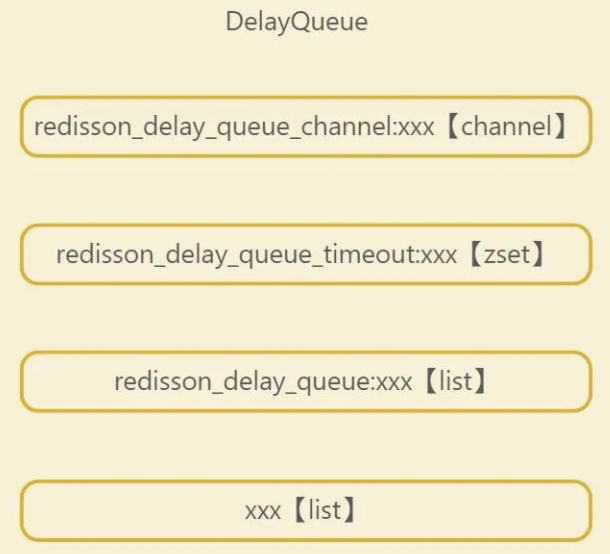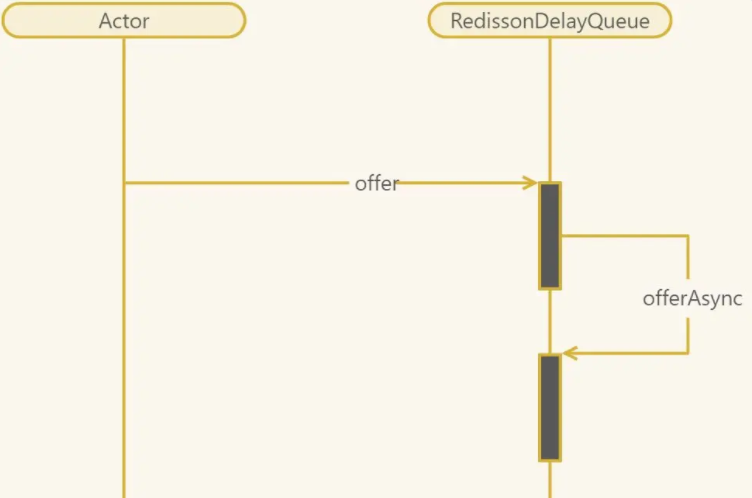How Redis implements delay queue
Use
Dependency configuration
<?xml version="1.0" encoding="UTF-8"?>
<project xmlns="http://maven.apache.org/POM/4.0.0" xmlns:xsi="http://www.w3.org/2001/XMLSchema-instance"
xsi:schemaLocation="http://maven.apache.org/POM/4.0.0 https://maven.apache.org/xsd/maven-4.0.0.xsd">
<modelVersion>4.0.0</modelVersion>
<parent>
<groupId>org.springframework.boot</groupId>
<artifactId>spring-boot-starter-parent</artifactId>
<version>2.3.12.RELEASE</version>
<relativePath/> <!-- lookup parent from repository -->
</parent>
<groupId>com.homeey</groupId>
<artifactId>redis-delay-queue</artifactId>
<version>0.0.1-SNAPSHOT</version>
<name>redis-delay-queue</name>
<description>redis-delay-queue</description>
<properties>
<java.version>1.8</java.version>
</properties>
<dependencies>
<dependency>
<groupId>org.springframework.boot</groupId>
<artifactId>spring-boot-starter-data-redis</artifactId>
</dependency>
<dependency>
<groupId>org.springframework.boot</groupId>
<artifactId>spring-boot-starter-web</artifactId>
</dependency>
<!-- https://mvnrepository.com/artifact/org.redisson/redisson -->
<dependency>
<groupId>org.redisson</groupId>
<artifactId>redisson-spring-boot-starter</artifactId>
<version>3.19.3</version>
</dependency>
<dependency>
<groupId>org.redisson</groupId>
<artifactId>redisson-spring-data-23</artifactId>
<version>3.19.3</version>
</dependency>
</dependencies>
<build>
<plugins>
<plugin>
<groupId>org.springframework.boot</groupId>
<artifactId>spring-boot-maven-plugin</artifactId>
<configuration>
<excludes>
<exclude>
<groupId>org.projectlombok</groupId>
<artifactId>lombok</artifactId>
</exclude>
</excludes>
</configuration>
</plugin>
</plugins>
</build>
</project>Note: Handle redisson and springboot compatibility issues
Configuration file
There are three ways for springboot to integrate redisson
The first: general redis configuration redisson automatic configuration [the simplest]
The second type: Use a separate redisson configuration file
The third type: Use spring.redis.redisson to configure under the configuration key
For detailed integration, view springboot integrated redisson configuration
spring:
redis:
database: 0
host: localhost
port: 6379
timeout: 10000
lettuce:
pool:
max-active: 8
max-wait: -1
min-idle: 0
max-idle: 8demo code
package com.homeey.redisdelayqueue.delay;
import lombok.RequiredArgsConstructor;
import lombok.extern.slf4j.Slf4j;
import org.redisson.api.RBlockingQueue;
import org.redisson.api.RDelayedQueue;
import org.redisson.api.RedissonClient;
import org.springframework.context.annotation.Bean;
import org.springframework.context.annotation.Configuration;
import org.springframework.stereotype.Component;
import javax.annotation.PostConstruct;
import java.util.concurrent.ExecutorService;
import java.util.concurrent.Executors;
import java.util.concurrent.TimeUnit;
/**
* 明天的你会因今天到的努力而幸运
*
* @author jt4mrg@qq.com
* 23:11 2023-02-19 2023
**/
@Slf4j
@Component
@RequiredArgsConstructor
public class RedissonDelayQueue {
private final RDelayedQueue<String> delayedQueue;
private final RBlockingQueue<String> blockingQueue;
@PostConstruct
public void init() {
ExecutorService executorService = Executors.newFixedThreadPool(1);
executorService.submit(() -> {
while (true) {
try {
String task = blockingQueue.take();
log.info("rev delay task:{}", task);
} catch (Exception e) {
log.error("occur error", e);
}
}
});
}
public void offerTask(String task, long seconds) {
log.info("add delay task:{},delay time:{}s", task, seconds);
delayedQueue.offer(task, seconds, TimeUnit.SECONDS);
}
@Configuration
static class RedissonDelayQueueConfigure {
@Bean
public RBlockingQueue<String> blockingQueue(RedissonClient redissonClient) {
return redissonClient.getBlockingQueue("TOKEN-RENEWAL");
}
@Bean
public RDelayedQueue<String> delayedQueue(RBlockingQueue<String> blockingQueue,
RedissonClient redissonClient) {
return redissonClient.getDelayedQueue(blockingQueue);
}
}
}execution effect

principle analysis
From RedissonDelayedQueueIn the implementation we see four roles

##redisson_delay_queue_timeout:xxx, sorted set data Type, stores all delayed tasks, sorted according to the expiration timestamp of the delayed tasks (the timestamp delay time when the task is submitted), so the first element at the front of the list is the earliest task to be executed in the entire delayed queue , this concept is very important
redisson_delay_queue:xxx, list data type, I have not found any use for the time being, but it will be written here when submitting the task, queue transfer The elements inside will be deleted
xxx: list data type, which is called the target queue. The tasks stored in this queue have all reached the delay time. Tasks that can be obtained by consumers, so the take method of RBlockingQueue in the demo above obtains the task
redisson_delay_queue_channel:xxx from this target queue, which is A channel used to notify the client to start a delayed task
RedissonDelayedQueueWhen the delayed queue is created, the queue transfer service is specified. As well as the four important color correction keys for implementing the delay queue. The core code is to specify the queue transfer task
QueueTransferTask task = new QueueTransferTask(commandExecutor.getConnectionManager()) {
@Override
protected RFuture<Long> pushTaskAsync() {
return commandExecutor.evalWriteAsync(getRawName(), LongCodec.INSTANCE, RedisCommands.EVAL_LONG,
"local expiredValues = redis.call('zrangebyscore', KEYS[2], 0, ARGV[1], 'limit', 0, ARGV[2]); "//拿到zset中过期的值列表
+ "if #expiredValues > 0 then " //如果有
+ "for i, v in ipairs(expiredValues) do "
+ "local randomId, value = struct.unpack('dLc0', v);"//解构消息,在提交任务时打包的消息
+ "redis.call('rpush', KEYS[1], value);" //放入无前缀的list 队头
+ "redis.call('lrem', KEYS[3], 1, v);"//移除带前缀list 队尾元素
+ "end; "
+ "redis.call('zrem', KEYS[2], unpack(expiredValues));" //移除zset中本次读取的过期元素
+ "end; "
// get startTime from scheduler queue head task
+ "local v = redis.call('zrange', KEYS[2], 0, 0, 'WITHSCORES'); "//取zset最小分值的元素
+ "if v[1] ~= nil then "
+ "return v[2]; " //返回分值,即过期时间
+ "end "
+ "return nil;",
Arrays.asList(getRawName(), timeoutSetName, queueName),
System.currentTimeMillis(), 100);
}
@Override
protected RTopic getTopic() {
return RedissonTopic.createRaw(LongCodec.INSTANCE, commandExecutor, channelName);
}
};
RedissonDelayedQueue#offerAsync
return commandExecutor.evalWriteNoRetryAsync(getRawName(), codec, RedisCommands.EVAL_VOID,
"local value = struct.pack('dLc0', tonumber(ARGV[2]), string.len(ARGV[3]), ARGV[3]);" //打包消息体:消息id,消息长度,消息值
+ "redis.call('zadd', KEYS[2], ARGV[1], value);"//zset中加入消息及其超时分值
+ "redis.call('rpush', KEYS[3], value);" //向带前缀的list中添加消息
// if new object added to queue head when publish its startTime
// to all scheduler workers
+ "local v = redis.call('zrange', KEYS[2], 0, 0); "//取出zset中第一个元素
+ "if v[1] == value then " //如果最快过期的元素就是这次发送的消息
+ "redis.call('publish', KEYS[4], ARGV[1]); " //channel中发布一下超时时间
+ "end;",
Arrays.asList(getRawName(), timeoutSetName, queueName, channelName),
timeout, randomId, encode(e));The above is the detailed content of How Redis implements delay queue. For more information, please follow other related articles on the PHP Chinese website!

Hot AI Tools

Undresser.AI Undress
AI-powered app for creating realistic nude photos

AI Clothes Remover
Online AI tool for removing clothes from photos.

Undress AI Tool
Undress images for free

Clothoff.io
AI clothes remover

AI Hentai Generator
Generate AI Hentai for free.

Hot Article

Hot Tools

Notepad++7.3.1
Easy-to-use and free code editor

SublimeText3 Chinese version
Chinese version, very easy to use

Zend Studio 13.0.1
Powerful PHP integrated development environment

Dreamweaver CS6
Visual web development tools

SublimeText3 Mac version
God-level code editing software (SublimeText3)

Hot Topics
 Solution to 0x80242008 error when installing Windows 11 10.0.22000.100
May 08, 2024 pm 03:50 PM
Solution to 0x80242008 error when installing Windows 11 10.0.22000.100
May 08, 2024 pm 03:50 PM
1. Start the [Start] menu, enter [cmd], right-click [Command Prompt], and select Run as [Administrator]. 2. Enter the following commands in sequence (copy and paste carefully): SCconfigwuauservstart=auto, press Enter SCconfigbitsstart=auto, press Enter SCconfigcryptsvcstart=auto, press Enter SCconfigtrustedinstallerstart=auto, press Enter SCconfigwuauservtype=share, press Enter netstopwuauserv , press enter netstopcryptS
 Analyze PHP function bottlenecks and improve execution efficiency
Apr 23, 2024 pm 03:42 PM
Analyze PHP function bottlenecks and improve execution efficiency
Apr 23, 2024 pm 03:42 PM
PHP function bottlenecks lead to low performance, which can be solved through the following steps: locate the bottleneck function and use performance analysis tools. Caching results to reduce recalculations. Process tasks in parallel to improve execution efficiency. Optimize string concatenation, use built-in functions instead. Use built-in functions instead of custom functions.
 Golang API caching strategy and optimization
May 07, 2024 pm 02:12 PM
Golang API caching strategy and optimization
May 07, 2024 pm 02:12 PM
The caching strategy in GolangAPI can improve performance and reduce server load. Commonly used strategies are: LRU, LFU, FIFO and TTL. Optimization techniques include selecting appropriate cache storage, hierarchical caching, invalidation management, and monitoring and tuning. In the practical case, the LRU cache is used to optimize the API for obtaining user information from the database. The data can be quickly retrieved from the cache. Otherwise, the cache can be updated after obtaining it from the database.
 Which one has better performance, erlang or golang?
Apr 21, 2024 am 03:24 AM
Which one has better performance, erlang or golang?
Apr 21, 2024 am 03:24 AM
There are performance differences between Erlang and Go. Erlang excels at concurrency, while Go has higher throughput and faster network performance. Erlang is suitable for systems that require high concurrency, while Go is suitable for systems that require high throughput and low latency.
 Caching mechanism and application practice in PHP development
May 09, 2024 pm 01:30 PM
Caching mechanism and application practice in PHP development
May 09, 2024 pm 01:30 PM
In PHP development, the caching mechanism improves performance by temporarily storing frequently accessed data in memory or disk, thereby reducing the number of database accesses. Cache types mainly include memory, file and database cache. Caching can be implemented in PHP using built-in functions or third-party libraries, such as cache_get() and Memcache. Common practical applications include caching database query results to optimize query performance and caching page output to speed up rendering. The caching mechanism effectively improves website response speed, enhances user experience and reduces server load.
 How to use Redis cache in PHP array pagination?
May 01, 2024 am 10:48 AM
How to use Redis cache in PHP array pagination?
May 01, 2024 am 10:48 AM
Using Redis cache can greatly optimize the performance of PHP array paging. This can be achieved through the following steps: Install the Redis client. Connect to the Redis server. Create cache data and store each page of data into a Redis hash with the key "page:{page_number}". Get data from cache and avoid expensive operations on large arrays.
 How to upgrade Win11 English 21996 to Simplified Chinese 22000_How to upgrade Win11 English 21996 to Simplified Chinese 22000
May 08, 2024 pm 05:10 PM
How to upgrade Win11 English 21996 to Simplified Chinese 22000_How to upgrade Win11 English 21996 to Simplified Chinese 22000
May 08, 2024 pm 05:10 PM
First you need to set the system language to Simplified Chinese display and restart. Of course, if you have changed the display language to Simplified Chinese before, you can just skip this step. Next, start operating the registry, regedit.exe, directly navigate to HKEY_LOCAL_MACHINESYSTEMCurrentControlSetControlNlsLanguage in the left navigation bar or the upper address bar, and then modify the InstallLanguage key value and Default key value to 0804 (if you want to change it to English en-us, you need First set the system display language to en-us, restart the system and then change everything to 0409) You must restart the system at this point.
 Can navicat connect to redis?
Apr 23, 2024 pm 05:12 PM
Can navicat connect to redis?
Apr 23, 2024 pm 05:12 PM
Yes, Navicat can connect to Redis, which allows users to manage keys, view values, execute commands, monitor activity, and diagnose problems. To connect to Redis, select the "Redis" connection type in Navicat and enter the server details.






